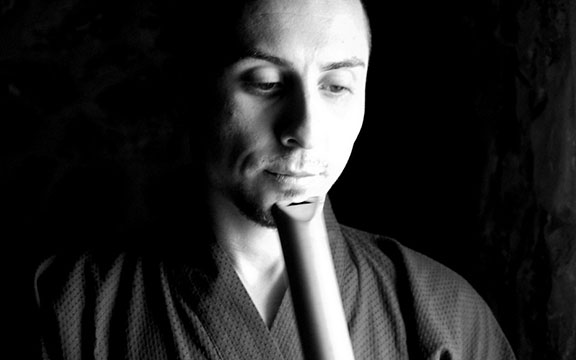
Rodrigo Rodríguez is a
Shakuhachi composer, musician and teacher. The
Shakuhachi is a Japanese wind instrument with some 500 years of history, from its origins the role of the instrument was linked to different genres of Japan to contemporary times as a fundamental instrument in the music of the Japanese culture. During the Nara period (710–794 AD), the
Shakuhachi was introduced as an instrument from China to Japan. The
shakuhachi was initially used for Gagaku court music. During the early Edo period, in the sixteenth century, Buddhist Monks called Komuso played the flute in a sacred form—a type of chanting . (Listen to Rodrigo
here. )
Born in Argentina, Rodrigo lived in Spain from 1986 where he spent most of his childhood. At an early age he began to study classical and modern music, and in his adolescence he experienced a great interest in traditional music and ethnic instruments. He studied classical and traditional music in Japan with the lineages of musicians and composers Katsuya Yokoyama and Kakizakai Kaoru. Subsequently, he studied with Kohachiro Miyata, one of the living legends of Shakuhachi in Japan. Since 2004, Rodrigo has achieved great successes and has performed in numerous concerts in Europe and Asia, in venues as legendary as the Imperial Hotel in Tokyo and the NHK Culture Center in Japan. In April 2018, Rodrigo first performed in New York City, where he was invited to perform at the Sakura Matsuri (Photo: Rodrigo Rodríguez playing flute at a festival at the Brooklyn Botanic Garden.)
Rodrigo explains that “The Shakuhachi is a very primitive instrument in its construction. It is built with a type of bamboo called madake. Bamboo is a very versatile material in the Asian continent, it is used in musical instruments, scaffolding, food, clothing production, etc. The utaguchi (Shakuhachi mouthpiece) portion is cut obliquely outward, and a small piece of fiber is often inserted to produce subtle variations in its sound. The campaign or root is made with the trunk of the bamboo with its root ends. A Chinese proverb is: ‘Be like the bamboo, the higher you grow the deeper you bow.'”
Originally, Shakuhachi was used to perform court music, gagaku (雅 楽), a word meaning “elegant music,” which is a type of classical music performed at the imperial court. At the beginning of the 16th century, it was used by Komuso monks, priests belonging to Zen Buddhism, who later developed a Suizen practice. Suizen practice can be understood in the context of ancient Chinese Buddhist classics that have had a profound influence on Japanese music, and use sound awareness as a means of illumination.
 Rodrigo Rodríguez is a Shakuhachi composer, musician and teacher. The Shakuhachi is a Japanese wind instrument with some 500 years of history, from its origins the role of the instrument was linked to different genres of Japan to contemporary times as a fundamental instrument in the music of the Japanese culture. During the Nara period (710–794 AD), the Shakuhachi was introduced as an instrument from China to Japan. The shakuhachi was initially used for Gagaku court music. During the early Edo period, in the sixteenth century, Buddhist Monks called Komuso played the flute in a sacred form—a type of chanting . (Listen to Rodrigo here. )
Rodrigo Rodríguez is a Shakuhachi composer, musician and teacher. The Shakuhachi is a Japanese wind instrument with some 500 years of history, from its origins the role of the instrument was linked to different genres of Japan to contemporary times as a fundamental instrument in the music of the Japanese culture. During the Nara period (710–794 AD), the Shakuhachi was introduced as an instrument from China to Japan. The shakuhachi was initially used for Gagaku court music. During the early Edo period, in the sixteenth century, Buddhist Monks called Komuso played the flute in a sacred form—a type of chanting . (Listen to Rodrigo here. )
